And that's a very good thing.
Jim knows more about the history of Greensboro, and about the history of Greensboro architecture, I think, than any living person.
He's also a very nice guy. I run into him fairly frequently, and I mean run -- he's a dedicated jogger, and our paths cross at races and sometimes while we're running on Elm Street.
He always says hello, but I don't think he quite knows who I am. No matter. He's an engaging writer, and I look forward to learning more about this city from his work.
You can start with his appreciation of David Hoggard, who he calls "a poor man's Jim Melvin." I passed that on to Hoggard on his front porch this evening -- he hadn't seen Schlosser's piece yet -- and he thought it was hilarious.
Monday, August 29, 2005
Jim Schlosser is blogging
Posted by
David Wharton
at
Monday, August 29, 2005
0
comments
![]()
Sunday, August 28, 2005
Country living
We took a break from urbanity this weekend to visit old friends who are building a beautiful place near Lexington, VA. Here's the view from what soon will be their front porch:
Clearly there's a strong case to be made for rurality. Especially when you can do this
in your front yard. I'm shown here attempting to ruthlessly mutilate a tin can. (I failed.)
Sam, too, enjoyed exercising his 2nd Amendment rights on his 16th birthday. Mrs. Urbanity also got a chance to shoot for the first time, but has forbidden me to post photos of her fetchingly firing her 20 gauge.
Our friends were wonderful hosts, and they showed us around the beautiful town Lexington (about whose historical treasures I'm tempted to gush embarassingly), Washington and Lee University, and VMI, which Sam liked, but which seemed forbidding to me.
Posted by
David Wharton
at
Sunday, August 28, 2005
1 comments
![]()
Friday, August 26, 2005
Ahhhhhhh . . . .
The insect sounds have changed at night.
It's cooler, and the whine of cicadas has given way to subdued cricket chirping not long after sunset. It sounds good and feels good.
I never bothered to drag our window unit up to our bedroom this summer. That room doesn't have central air because doing the ductwork must have been a little too challenging back in the 30's when our coal-grate fireplaces and stoves were retired in favor of central heat.
So through this summer, Laurette and I were cooled only by the good cross-ventilation of our bedroom (windows on 3 walls) and a ceiling fan. Some nights it was pretty warm. But as you know if you've ever seen Body Heat, sweat is not always a bad thing . . .
Anyhow.
It got down into the 60's last night, and that felt pretty good, too.
Posted by
David Wharton
at
Friday, August 26, 2005
3
comments
![]()
Suburban mom in the city
Reedy Fork mom Kim took her son on a trip downtown today, and they both loved it:
. . . . . I really needed a city fix. I was just starting to feel too isolated . . . . I'm telling you, it was wonderful. The sights, the sounds and even the smells. There were horns beeping, business people scurrying around, there were people enjoying lunch at outdoor cafes, there were people selling hotdogs . . . . We saw all sorts of people from those who were just looking around like us, business people, kids, residents of downtown and my next door neighbor who was sitting in his patrol car at a traffic light.She liked it so much, she's pondering her next residence:
During our time downtown I was thinking about how nice it would be to live downtown. I noticed really nice looking condos that I would love to see the inside of. I used to think I would never want a condo because I thought it would be like apartment living, but I'm starting to re-think that.Interesting. She would certainly have plenty of choice in condominiums.
Kim's an engaging blogger; Read the whole thing.
Posted by
David Wharton
at
Friday, August 26, 2005
0
comments
![]()
Bikepool! or, Bike lanes? We don't need no stinkin' bike lanes
A mini-flyer appeared on my Kymco and on every bike on the bike rack in front of my building yesterday:
I guess a lot of these students have already taken the no-car option, and are having fun doing it. Where they lead, city transporation planners will follow, I think.GREENSBORO FEST!!
A four nite (free) event with bands and bike-pooling to the shows! Each nite (except for Sat.) meet @ 7:30 p.m. on College Ave. in front of the UNCG Jackson library for a group ride to the shows.
In case you want to party with these cycling hipsters, here's the show info:
Friday Aug. 26: Guilford College with Dawn Chorus, Chet Stedman, Citified.
Saturday Aug. 27: UNCG Faculty Center with Giant, Eugene Chadbourne, 6 p.m. Filthy Bird, Tiger Bear Wolf
Sunday Aug. 28: Green Street with Boxcar Bertha, Crimson Spectre, Mortar & Pestle, War! Bomb!
Posted by
David Wharton
at
Friday, August 26, 2005
0
comments
![]()
Thursday, August 25, 2005
School's NOT out forever
And thank goodness for that!
That sound you're hearing all over Guilford County today is coming from parents who are cheering and sighing as they send their children back to school.
But you may also be picking up a low grumbling sound, if our experience is anything like that of other parents.
Here's a photo of my daughter waiting for her school bus (accompanied by Sweetfoot, whose nickname is Jabba the Cat, for obvious reasons). After waiting 40 minutes, we gave up and drove her to school. I think you'll be reading about bus snafus in tomorrow's News & Record.
I think you'll be reading about bus snafus in tomorrow's News & Record.
Posted by
David Wharton
at
Thursday, August 25, 2005
1 comments
![]()
Wednesday, August 24, 2005
Zoning enforcement blues: 351 Summit Avenue update
Effective code and zoning enforcement is an essential element in revitalizing and maintaining older urban neighborhoods. Without them, irresponsible, predatory, or just plain lazy propery owners can bring real estate values in a neighborhood crashing down.
A while back I noticed that an illegal junkyard had taken root just ouside my neighborhood -- hardly more than a stone's throw from my house, and I put up a post about my efforts to get the situation remedied.
Well, the situation still isn't fixed. The junkyard is still there, though the owners have begun putting a six-foot privacy fence around it. I think they're doing this in response to prodding from the city's zoning enforcement staff.
Here's the relevant bit of zoning ordinance:
Section 30-5.2.48(2) Junked motor vehicles (as an accessory use). Nonresidential Districts: Any vehicle meeting the definition of "Junked Motor Vehicle" shall be stored, parked, or placed on the property in such a manner so as to be screened from view from any street and/or from any adjacent residentially or public and institutionally zoned property. Total screening shall be effected by placement of the vehicles, either within or behind a building, or by plant materials, fences, berms, or a combination thereof, with a minimum height off six (6) feet [my emphasis].So it would seem that putting up a six-foot privacy fence would solve the problem, right?
I don't think so.
First of all, the junkard in this instance is the primary use of the property, not an accessory use. Secondly, the six-foot privacy fence does not screen the junked vehicles from view from the street, as this photo taken from Fisher Avenue clearly demonstrates:
 This fall, when the leaves are gone, the junkard will be even more exposed.
This fall, when the leaves are gone, the junkard will be even more exposed.
I'm corresponding with city staff on this issue, and will keep you updated as to their determination. But to be honest, I'm having a bad feeling about this. I've never had a go-round with zoning staff in which they agreed with my interpretation of the ordinance.
What do you think?
Posted by
David Wharton
at
Wednesday, August 24, 2005
5
comments
![]()
The $13,000 parking space
UNCG students are getting lots of parking tickets, and they're pissed.
The Carolinian (UNCG's student-run newspaper) reports that some students who have been sold parking permits are unable to find spaces and are being ticketed when they park illegally.
The article seems to imply that the university has sold more B-lot spaces to resident students than it actually has. I don't know whether that's true -- but didn't Jim Bakker go to jail for doing something like that a few years back? I can understand the students' anger if it's so.
UNCG Parking director Kristy Bradley is quoted as saying that the cost of building a new parking space in a deck on campus is $13,000. And that's just initial capital outlay; when you figure in deck maintenance and administration I'll bet it's a lot more.
Which means that the $375 that the university charges for a yearly deck pass doesn't really cover the cost of parking; it just covers the initial building cost of the space for the 35-year life of the deck.
That may seem like a lot of money for a deck pass, but I think it's too little, and here's why.
Sophomore student Hannah Simms is quoted as saying,
"Resident students should have deck passes, because while day students may be here for eight hours . . . residents may not move their car for two months."Two months? If Hannah is right, that means UNCG's parking rates are so low that students are willing to pay it simply to store unused vehicles.
UNCG does not have a parking problem. It has a pricing problem. The demand for parking spaces is artificially high because they are priced too cheaply. If the university charged for spaces at their true market value, students would find other ways to handle their transportation needs.
It can be done: I spent 2 years in Chapel Hill with a bicycle as my only vehicle (I was in my late 20's at the time). And even now I almost never drive a car to campus; when I do, I find free parking in College Hill.
Update: Sue points out in comments that scooters aren't for everbody, and she's right. But they're getting more popular, as this picture taken in front of my building shows.
Udate II: Councilwoman Sandy Carmany writes in the comments: "UNCG is participating in the funding of the local match money needed for GTA's University Connector service that will provide students alternate ways to get to the campus without having to drive and hunt for parking spaces." That's good news for students.
Posted by
David Wharton
at
Wednesday, August 24, 2005
19
comments
![]()
Tuesday, August 23, 2005
Now THAT's what I call adaptive re-use
You probably haven't heard of Erbil in Iraq (I hadn't). But it might be the longest continually-occupied site in the world.
"The thing about Erbil is that it is, in fact, a living town," Dr. Gibson said. "It goes back at least to 5,000 B.C.," he said. "It might go back further."
Some estimates put the town's beginnings as far back as 9,300 B.C.
Read the whole thing, especially the part about the Frenchman displaying avant-garde paintings in an ancient bath next to a mosque. Some hope to make Erbil the Kurdish Soho.
Posted by
David Wharton
at
Tuesday, August 23, 2005
0
comments
![]()
Sunday, August 21, 2005
Someone I think about when I run
My dad has been going through boxes of old family photos and scanning them; here's one I particularly like:
That's my grandfather, Russell F. Wharton, third from the left, running for the University of Illinois against Wisconsin in 1921.
He was a very good miler for his day, and he ran on a 4-mile relay team in the Drake Relays that set a world record in the early 20's. In 1921 he was a Big 10 2-mile champion with a time of 9:43.2.
Though I'm strictly a middle-of-the-pack, middle aged jogger, I sometimes think about him in his prime when I'm running, and he makes me run a little faster.
Posted by
David Wharton
at
Sunday, August 21, 2005
0
comments
![]()
Why no bike lanes, Jim?
Sunday's N&R included two long pieces (not posted on the N&R site) on the state of bicycling in Greensboro: one by citizen-bicyclist Jody Deitrich, the other by GDOT-Director-and-bicyclist Jim Westmoreland.
Both are avid cyclists (Jim's also an amateur bike racer), and both told harrowing stories about being struck by cars and having insults and objects thrown at them by motorists. Both of them think that cycling should be safer in Greensboro, and offered concrete ways to make it so.
But among Jim's several policy prescriptions for improving safety for cyclists, one was notable for its absence: he made no mention of bike lanes.
Jody did, though, and she mentioned cities (Palo Alto, CA, and Portland, OR) where this strategy has been popular and effective. Adding bike lanes is also recommended by this policy paper posted on the National Highway Traffic Safety Administration's website.
Now, we all know that Greensboro ain't Palo Alto. But I've also seen a lot of bike lanes in towns like Iowa City, Iowa, and Madison, Wisconsin. Why not here?
Bike lanes not only provide a safer environment for cyclists, but also say to everyone, "bicycles are welcome here."
I think that's exactly the message GDOT should be sending to motorists and cyclists alike.
Posted by
David Wharton
at
Sunday, August 21, 2005
7
comments
![]()
Saturday, August 20, 2005
Thursday, August 18, 2005
Shifting into condos
In this morning's Wall Street Journal:
As condominium prices reach never-before-seen heights, a debate is brewing over whether a fundamental demographic shift is driving the trend or whether this is simply the latest speculative bubble . . . last year, for the first time . . . the national median price of a condo was higher than that of a single-family home.Whether it's a shift or a bubble, something interesting is going on here in Greensboro. Condos and townhomes are sprouting up in places that builders would have turned their noses up at just a few years -- months? -- ago.
The amazing success of Southside at the south end of downtown has pushed the next phase of that development into full swing. This building on MLK Boulevard just sprang up in the past few weeks:
 Another big multifamily building is going up on MLK, and just about every empty lot in the single-family section is being prepped for construction. The common wisdom about this area is that it's for young singles, but I keep running into moms with strollers when I jog through, and a friend of mine and his wife who are new parents of newborn twins will soon be moving into this house:
Another big multifamily building is going up on MLK, and just about every empty lot in the single-family section is being prepped for construction. The common wisdom about this area is that it's for young singles, but I keep running into moms with strollers when I jog through, and a friend of mine and his wife who are new parents of newborn twins will soon be moving into this house: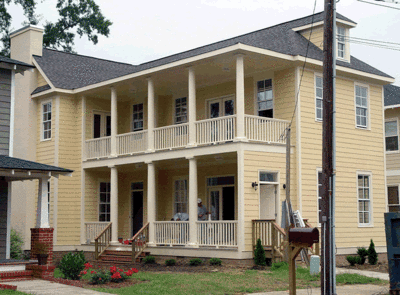
And there's more development to come at Southside:
The view of this sign is from Southside to East Lee Street. That's right, East Lee Street. Former home of the Rose Health Spa (!) and Dolls of the Orient massage parlor. Note the formerly dilapidated house that is undergoing renovation. If I'd have told people two years ago that someone was planning luxury tower condominiums on this section of East Lee, I'd have been laughed out of town.
And that little phrase on the sign, "at Southside" speaks volumes about Southside's status as a hot location. Compare the real estate sign below that reads, "at Irving Park." Southside, you have arrived.
Of course Southside wasn't the first condominium development downtown. The Lofts at Greensborough Court have been here for a while: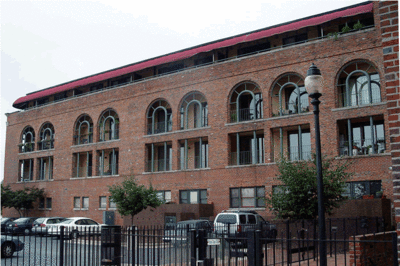
And of course there's Governors Court a few blocks away, and the Smothers Place Lofts, just across South Elm, look to be about ready for occupation. But the trend is spreading further.
A few blocks up North Elm, John Stratton's Magnolia Place, which I wrote about previously, is coming together.
John had to work hard to make his condominium project fit into the Fisher Park Historic District; here you can see the single-family bungalow that he's building to transition the housing types from Magnolia Court to Elm St. In the foreground are the brick foundations of the condominium buildings.
Further up North Elm, across from Irving Park, Greensboro's premier old-money neighborhood, still more condominiums are going up: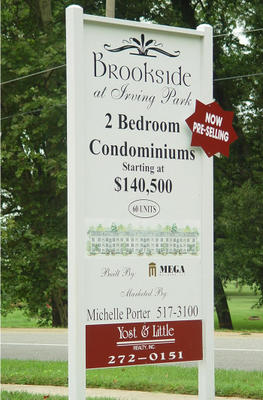

Amazingly, these will be lower priced than the one at Southside and East Lee, and judging from the artist's renderings on the signs, they don't look nearly as interesting as the Tower Homes.
But there's more! Kavanaugh Builders will be erecting new townhomes a couple of blocks from the new downtown First Horizon Park in the Cedar Street neighborhood. That neighborhood has some great architecture and a lot of funky charm, but it definitely has a few seedy spots too.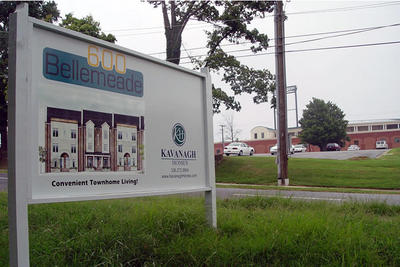
Also for sale in this area are the 6 condominiums at Vick Commons, lovingly restored by Dawn Chaney.
And of course 36 one-bedroom condominiums and 24 townhouses are proposed for my own neighborhood in the Dunleath development, right around the block from me. Hoggard has blogged about it pretty fully.
I voted to approve the conceptual plan of Dunleath at the last meeting of the Greensboro Historic Preservation Commission. It passed 6-1.
My experience with people who live in, or want to live in, housing like this seems to be telling me that there is a demographic shift going on.
A new friend of our family, a married mother of two girls, who is building a new house in Hamilton Lakes (a very traditional, single-family neighborhood), was upset when she found out about all the multifamily housing downtown because her realtor hadn't bothered to show it to her. "I'd have moved downtown if I'd known about all this stuff," she told us.
UPDATE: Hoggard asks,
When even old-school single-family-home builders such as Kavanagh start scrambling to get a piece of the action, can drug stores, grocery stores, dry-cleaners, and the like, be far behind?Let's hope not.
And Ed Cone notes that the Rose Health Spa and Dolls of the Orient are a few blocks away on West Lee Street (not East Lee), but won't say how he knows.
Vada says there are plans to make the old Rose Spa into art space. Very cool. (I didn't mean to imply earlier that it's begin replaced with condos -- just that they'll be nearby.)
Finally, another condominium tidbit from Friday's Wall Street Journal: Las Vegas, which has always seemed to me to be super-sprawlsville, has 40,000 condominium units currently in the planning stages. Wow.
I think, a big, new chunk of the middle class doesn't like yardwork.
Posted by
David Wharton
at
Thursday, August 18, 2005
10
comments
![]()
Movable type
I ranted a little while back about one of my favorite bloggers because, I said, he lacked a sense of history -- comparing blog technology to CB radios, when I though he should be comparing it to movable type.
Well, he did compare blogging to movable type here, back in 2002.
So I was wrong.
Posted by
David Wharton
at
Thursday, August 18, 2005
0
comments
![]()
Wednesday, August 17, 2005
Come on and take a free ride
Councilwoman Sandy Carmany is publicizing Greensboro's Dump the Pump campaign on her blog, the point of which is to get people out of their cars and into public transportation.
GTA is offering free trial passes, and I'm going to take them up on it.
Driving to work is expensive for me (because of parking); riding my scooter is cheaper (but not fun in the rain); walking is just a little too far (50 minutes).
If the bus can get me to work efficiently, I might think about dumping not just the pump, but one of my cars, too.
Posted by
David Wharton
at
Wednesday, August 17, 2005
6
comments
![]()
Fixing the Mall of America
No, I don't mean this one. I mean this one.
Andrew Ferguson (of all people!) has a great piece in the Weekly Standard about the troubled future of the Washington Mall, one of my all time favorite public places.
Although he wisecracks about planners --
Urban planners are like libertarians: They're wonderful to have around so long as their advice is never, ever followed all the way through.-- he also admits that most of what's good about the Mall is a result of their work, and comes to the reluctant conclusion that an intervention by do-gooding, buttinsky urban planners is necessary to make sure the Mall will be a great public place in the next century.
Read the whole thing.
Posted by
David Wharton
at
Wednesday, August 17, 2005
0
comments
![]()
Exurbia in Davidson County
According to the News & Record, a company called Shugart Management wants to build a new development in N.E. Davidson County, far outside the current High Point city limits, and is asking High Point to annex the property.
The proposal has been rejected by the city's planning and zoning commission and the city's planning department, but is favored by the planning and development commission (I wonder what the representation of the development industry is on that comission.)
City planners . . . questioned whether the city could afford to provide services to an area so far from the existing city limits . . .A cost-benefit analysis done by the city showed a net economic benefit of $191,989 over 5 years, but city council candidate Michael Pugh said the city had used "fuzzy math."
You don't have to be a liberal (and I'm not) to question whether this kind of growth actually pays its own way or whether the benefits outweight the costs. And I wrote earlier about why I don't like the social consequences of developments like this. I think they encourage social and civic fragmentation.
Here's a related national story.
Posted by
David Wharton
at
Wednesday, August 17, 2005
0
comments
![]()
Tuesday, August 16, 2005
Design and architecture podcasts; smart cars
Radio Station KCRW in Santa Monica, CA offers podcasts of its monthly design and architecture show. Nice of them to share with those of us who don't have radio programs about design in our own towns.
Among the shows is a segment about the smart car, a subject that often comes up when I tell people that I commute to work on a 50cc motor scooter.
What's a smart car? It's "a tiny two-seater so adorable that visiting Americans want to put it in their pockets and bring it home" when they see one in Europe. Read more here. You can buy one in 2006.
Posted by
David Wharton
at
Tuesday, August 16, 2005
1 comments
![]()
Monday, August 15, 2005
The Tar Heel Tavern is up!
Here's Tar Heel Tavern #25. Thanks, Mandie, for putting it together!
Posted by
David Wharton
at
Monday, August 15, 2005
1 comments
![]()
Giving homebuyers what they want -- a sense of security
The NY Times covers trends in exurban development, which ranges from the new-urbanish (though somewhat disneyfied) Avalon Park, to much more traditional suburban-like development with larger lawns and cul-de-sacs.
The good news: these are not the white-flight suburban enclaves of the 60's and 70's. As in Greensboro's Reedy Fork Ranch, the people living in the new developments are very comfortable with racial mixing. For example, in Tampa's New River development, the residents are 38 percent Hispanic, 24 percent white and 16 percent black. But most of these folks do have something in common: 75% of them have children.
Here's a part that bothered me, though:
In its most recent survey of Tampa home buyers, KB Home asked people what they valued the most in their home and community. They wanted more space and a greater sense of security. Safety always ranks [high], even in communities where there is virtually no crime. Asked what they wanted in a home, 88 percent said a home security system, 93 percent said they preferred neighborhoods with "more streetlights" and 96 percent insisted on deadbolt locks or security doors....[T]he company designs its communities with winding streets with sidewalks and cul-de-sacs to keep traffic slow, to give a sense of containment and to give an appearance distinctly unlike the urban grid that the young, middle-class families instinctively associate with crime.The desire to keep one's family safe from crime is entirely understandable. But I wonder to what extent the fear of crime is disproportionate to real risks. Is it possible that the flight to secluded exurbs is being wrongly fueled by local TV newscasts hyperventillating over crime, by crime dramas like CSI, and by "reality"-based shows like America's Most Wanted and Cops?
It also rankles me somehow to think that people who have the social and organizational skills that would most benefit urban neighborhoods are taking their social capital out to the exurbs where it sits mostly unused.
Exurbanites seem to be cherry-picking urban benefits such as jobs, business and government connections, and culture and entertainment, while leaving the dirty work of city life to others.
Not to mention that their flight to far-flung communities forces governments to build and maintain a whole lot of new road capacity to carry those commuters. Are the exurbs paying their fair share for the new roads? I'd like to find out. And if they're not, I'd like to find some way to make sure that they do.
Posted by
David Wharton
at
Monday, August 15, 2005
3
comments
![]()
Sunday, August 14, 2005
"Centering Down"
Ed Cone's column today is especially delicious and nuggety; just click the link and enjoy yourself.
One of my favoite parts: Ed muses on why his great-grandfather Cone used regularly to row himself to the center of a lake and just sit in the boat:
Centering down, the Quakers call it, reaching a quiet core of your self, and it is all the more essential today in a culture that has lost its appreciation for silence and gentle ambient sounds. The boom-box on the beach that drowns out the waves, the iPod carried on a run around the park, the cell phone required for any car trip longer than five minutes -- it's as if people are afraid to be alone with themselves.Yes, exactly.
This morning I ran in Country Park, watching shafts of light come through the tree canopy and illuminate the humid air, listening to the shudder and whine of August's aging cicadas, and to footfalls, and to breathing.
Centering down.
UPDATE: After I posted this, my body told me I'd run a bit too far this morning (trying to make up for lapses in my marathon training). So I had to take a couple of Advils and spend the afternoon "centering down" on the bed watching Columbo reruns. Heavenly -- especially when Johnny Cash is the guest star.
Posted by
David Wharton
at
Sunday, August 14, 2005
0
comments
![]()
Saturday, August 13, 2005
More Walking Blues
Jason Hardin wrote a great piece today about problems for pedestrians in Greensboro.
The most telling bits of his research, I think, are the study by the Surface Transportation Policy Project that shows we're the 7th most dangerous place for pedestrians in the country, and a RAND corporation study that rates the Triad as the 2nd most sprawling metropolitan area in America.
Let's add to that the STPP study that shows sprawl is associated with increased obesity and high blood pressure.
Unfortunately, Jason's excellent article was marred by quotations from a pedestrian-extremist blogger. Whatever is becoming of journalistic standards?
Posted by
David Wharton
at
Saturday, August 13, 2005
9
comments
![]()
Friday, August 12, 2005
Burgers by Biff
Tina Firesheets wrote a nice appreciation of West Lee Street's Biff's Beef Burger restaurant in todays News & Record.
The burgers there are good, and the architecture and decor are classic 1950's garish (I love it!), but for me the best part of Biff's is no drive through. I've never been in that restaurant without having a friendly conversation with another customer or employee.
Posted by
David Wharton
at
Friday, August 12, 2005
0
comments
![]()
Thursday, August 11, 2005
The Silence of the Astrakhan
Big Fashion -- can we talk about Big Fashion the way we talk about Big Oil and Big Food? Let's do! -- is pushing a new kind of fur this fall: astrakhan. It's actually an old kind of fur with a new name.
It used to be called "Persian lamb, karakul, or in some cases broadtail," according to the NY Times. (I'm convinced that the new name is an attempt to ride the coattails of Harry Potter.)
Astrakhan is the wooly lamb skin of the karakul sheep, and, apparently, the younger the lamb, the finer the fur. Good astrakhan comes from sheep just a few days old. For the very finest fur, called "broadtail," you have to harvest the lambs before they are born. Lamb fetuses.
But for designer Carmen Marc Valvo, "That's just a little too much." So also for designer Albert Kriemler. "[He said] he would never use broadtail from a lamb fetus. The astrakhan in his designs comes from naturally born lambs . . ."
Other designers seemed similarly squeamish.
Several designers would not directly answer whether the furs they call astrakhan come from fetal lambs, but a representative for Dolce & Gabbana confirmed it uses both types in its fall collection. A spokeswoman for Marc Jacobs, whose fall collection includes an astrakhan coat trimmed with ruffles, carried by Barneys New York, said she could not determine whether it was broadtail. Prada, which has frequently identified its product as broadtail, did not respond to numerous inquiries. A spokeswoman for Mr. Armani said the fur described as astrakhan in his fall collection is not fetal lamb.What the heck is going on here?
You may accuse me of unwarranted stereotyping if you wish, but I'm guessing that pretty much all of these designers are fully paid up members of pro-choice charities and organizations, and would probably support a woman's right to an abortion right up through the third trimester.
But they're trying to appear more humane in the fur world by saying they don't use lamb fetuses for their fur, but rather slaughter them after they're born?
Wait, wouldn't it be more humane to kill the fetuses? I'm not getting this.
Posted by
David Wharton
at
Thursday, August 11, 2005
11
comments
![]()
Wednesday, August 10, 2005
Hello Mudda, hello Blogga, or: How Greensboro101.com delivered mail from camp
We got a camp letter from my son Sam today, but in a very unusual way.
He has spent the past 3 ½ weeks at Camp Highlands for Boys, a place he loves, but which normally allows communication only through the US Postal Service. No phone, no e-mail, no faxes, except in emergencies.
So I was quite amazed this afternoon to see, as I was scanning this afternoon's blog posts on Greensboro101.com, a new post on Absolutely American, which is Sam's blog. The camp director, Mike Bachman, apparently approves of blogging and gave Sam special permission to post.
How utterly odd to stumble onto Sam's account of his near-disastrous fishing trip, published to the world – and already commented on! – and to come across it only by the merest chance while browsing our local "citizens' media" blog aggregator.
Sam will be home on Saturday: tanned, rested, and ready to take on the left-leaning local blogosphere. Ed and Roch, be afraid!
Me, I will be so glad to see that boy again.
Posted by
David Wharton
at
Wednesday, August 10, 2005
0
comments
![]()
The once and future New Urbanist
The Guardian: "The Prince of Wales has resumed his diatribe against postwar architecture by condemning cheap and 'ideological' urban redevelopment and reiterating his desire to see new 'human-scale' homes."
OpinionJournal's Best of the Web wisecracks, "You mean like Buckingham Palace?"
Huh! Don't they know the Prince's official residence is Clarence House? And the new-urbanist village of Poundbury that he oversaw looks pretty nice.
Posted by
David Wharton
at
Wednesday, August 10, 2005
0
comments
![]()
Classics in the news #534
Ann Althouse, guest-blogging for Glenn Reynolds at Instapundit, asks, "SHOULDN'T JOURNALISTS APPLAUD the passing of 'Jovian authority'?"
She links to an Oxblog post discussing the death of Peter Jennings, and the NY Times and Washington Post's nostalgia for the once-Olympian authority of the network anchor men.
But, hey, I'm just pumped that journalists are still using words like Jovian in articles that aren't about astronomy.
Maybe there's hope for saturnine, Apollonian, mercurial, and dionysiac.
UPDATE: The Wall Street Journal editorial page headlined a letter to the editor with this: Si vis pacem, para bellum. And they didn't even provide a translation! They just figured their readers knew what it meant.
Posted by
David Wharton
at
Wednesday, August 10, 2005
1 comments
![]()
Tuesday, August 9, 2005
A summer evening's walk for fat-bombs
A few minutes after I put up my previous post, my girls began lobbying me to take them to Ganache for dessert. Uh oh.
Sensing an imminent "hypocricy moment," I acquiesced only on condition that we walk to Ganache. They complained bitterly at first, but finally gave in (it's only a 10-minute walk from our house).
The Ganache cakes were great, as always. The girls each had slice of Black Cow (chocolate cake with cream cheese frosting), and I had the Italian Creme. We sat on the roof, listened to the locusts, and discussed the water holding capacity of camels, the role of wealth in choosing a mate, and the decline of the martini.
On the way home the girls told jokes, had races (during which the remains of Claudia's boxed Black Cow were reduced to pulp), sang marching chants, and did much giggling.
Walking is good. Cake is good. Being the father of girls is good.
Posted by
David Wharton
at
Tuesday, August 09, 2005
1 comments
![]()
High Point Road is Killing People
And so is Battleground Avenue, and Summit Avenue, and any other road having a high density of fast-food joints with drive-thru windows, and a crummy pedestrian environment.
In an article in this morning's News & Record on N. C. Women's health, Greensboro cardiac physician Dr. Thomas Wall says,
. . . fast food and the convenient lifestyle [are] killing more people than tobacco ever killed in this country. (Read all of Elyse Ashburn's N&R article.)When Dr. Wall says "the convenient lifestyle," I'm guessing he means the "drive everywhere" lifestyle.
So places like Battleground Avenue and High Point Road, where you can choose to drive through, pick up, and eat in your car a dozen Krispy Kreme fat-bombs, or a bag full of ham and gravy aorta blockers at Biscuitville, or . . . well, take your pick, 'cause it's all there, but where you risk your life by trying to walk -- then places like this turn out to be a double whammy of fat-assed death.
Here's a radical suggestion: Push to rewrite zoning laws so as not to allow drive-through restaurants anywhere in town. They're bad for traffic congestion, bad for the pedestrian environment, bad for neighborhoods, bad for people's health.
Lots of zoning areas already don't allow drive-throughs, so the principle is already established in law.
Such zoning infringes nobody's right to cook, sell, or eat whatever food they want. It just means that people might have to walk a little bit to get to it.
Posted by
David Wharton
at
Tuesday, August 09, 2005
4
comments
![]()
Sunday, August 7, 2005
DUDEs, BANANAs, and CAVEmen
I just found out that our local planning vocabulary is impoverished.
Until recently, we could get by with simple terms like "naysayer," "NIMBY," "developer," and "TREBIC" to describe the players in the local planning and development scene.
But Sue Schwartz of Greensboro's deptarment of Housing and Community Development (not Action Greensboro's Sue Schwartz) sent me a link that has opened up a whole new language of development to me.
For example, BANANA is not just a fruit any more. It means Build Absolutely Nothing Anywhere Near Anything. And a DUDE? It's a Developer Under Delusions of Entitlement. And CAVEmen? Citizens Against Virtually Everything.
Now what about GUMBY, QUIMBY, Ranchburger, Fauxburb, Gagplanistan, Taupeville, and Urban Fabric Softner? And what's an Italianalienate vavavoomburb? You'll just have to read the whole thing.
Thanks, Sue!
Posted by
David Wharton
at
Sunday, August 07, 2005
2
comments
![]()
Saturday, August 6, 2005
Old-and-New Charlotte Photo Travelogue
My girls were attending a 5-day Irish dance workshop in Charlotte all last week, and on Thursday I took a vacation day to carpool them and a couple of other dancers down to the Queen City.
Of course I took the opportunity to indulge in a little architectural photo tourism while they were learning new steps. I started in Dilworth, one of Charlotte's beautiful historic districts. As you can see from this photo, it's pretty close to downtown.
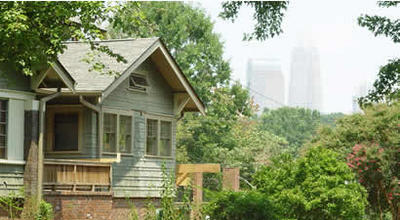 Dilworth is pretty big and I didn't have much time, so my photos probably aren't representative of the neighborhood as a whole. Most of the houses I saw (on and around Kingston St.) were quite modest.
Dilworth is pretty big and I didn't have much time, so my photos probably aren't representative of the neighborhood as a whole. Most of the houses I saw (on and around Kingston St.) were quite modest.
I particularly liked the pattern of shingles on this bungalow, which I haven't seen in Greensboro: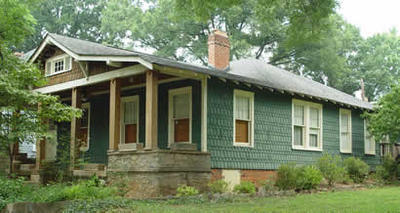 Some smart person a long time ago decided that utility lines in Dilworth should be strung in the alley right-of-ways behind the houses, which allows the growth of canopy trees between the street and sidewalk.
Some smart person a long time ago decided that utility lines in Dilworth should be strung in the alley right-of-ways behind the houses, which allows the growth of canopy trees between the street and sidewalk.
Even though the temperature was in the 90s, I was kept reasonably cool and comfortable walking the neighborhood because of that person's foresight. (Unfortunately this is not the arrangement through much of Greensboro's historic districts.)
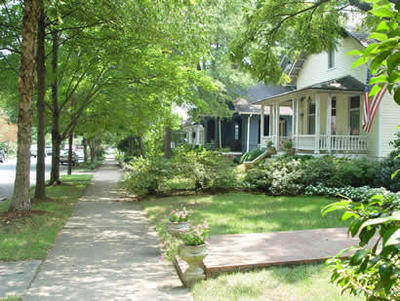 Dilworth seems to be attracting quite a bit of investment. For example, much of what you see in the picture below is an addition (garage and second story) to a craftsman bunglalow. One of the workmen I talked to indicated that the owner had at first wanted to tear down the original building, but "those historical people wouldn't let him."
Dilworth seems to be attracting quite a bit of investment. For example, much of what you see in the picture below is an addition (garage and second story) to a craftsman bunglalow. One of the workmen I talked to indicated that the owner had at first wanted to tear down the original building, but "those historical people wouldn't let him."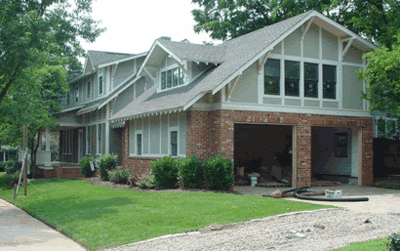 Those darn historical people!
Those darn historical people!
This section of Dilworth also had some really nice, old, multifamily buildings mixed in with the single-family houses: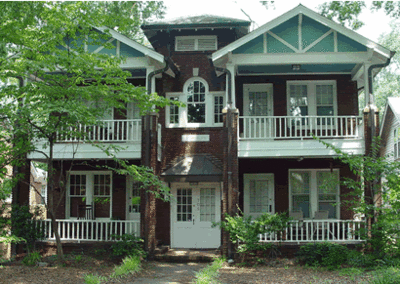
And this Queen-Anne style house doubles as a law office; it wasn't unusual even when these neighborhoods were new for people to use their houses as "live-work" units. Despite the mix of rental, business, and owner-occupied dwellings, real estate values were quite high. This fully renovated, 3,000 sq. ft. foursquare is for sale at an asking price of $905,000.
Despite the mix of rental, business, and owner-occupied dwellings, real estate values were quite high. This fully renovated, 3,000 sq. ft. foursquare is for sale at an asking price of $905,000.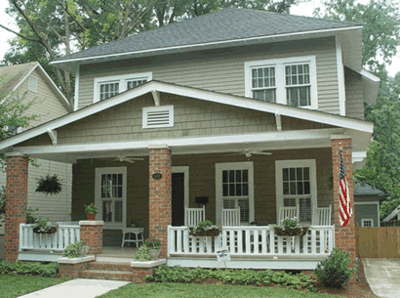 That's a price that would be envied even in Fisher Park, the priciest of Greensboro's historic districts.
That's a price that would be envied even in Fisher Park, the priciest of Greensboro's historic districts.
One of the things that makes Dilworth really livable is the nearness of shopping and recreation. You can easily walk to these shops and restaurants (some of my fellow preservationists might gag at the way these houses have been altered for commercial purposes -- but I think they did a good job of "adaptive re-use" here):
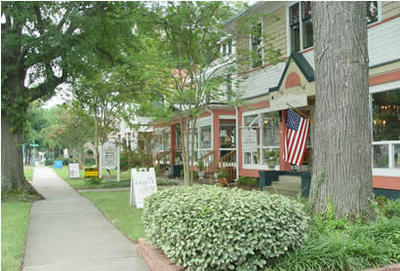 Or you can just as easily walk to the huge and beautiful Latta Park and cool off in the fountain:
Or you can just as easily walk to the huge and beautiful Latta Park and cool off in the fountain:
 I doubt whether all this just happened by accident. Dilworth is a good place because of some very good planning in the early 20th century.
I doubt whether all this just happened by accident. Dilworth is a good place because of some very good planning in the early 20th century.
And it's clear that planning is still going on. Where Dilworth runs into South Boulevard, you can see that Charlotte is working hard to integrate the new with the old. Lots of street construction is happening, and it apeared to me that the city is digging up South Boulevard's middle "suicide" lane to convert the street back to a true boulevard. That will make it not only more attractive, but a little more comfortable for Dilworth's pedestrians to cross.
New commercial construction on South boulevard seems to conform to a "pedestrian scale" design standard that brings the buildings up to the sidewalk and puts parking in the rear. I wonder how hard it was for the city to persuade Office Depot to build this . . .

. . . instead of doing the standard cinder block box in a puddle of asphalt that is the design standard here in Greensboro.
A little further up South Boulevard stands this new and impressive building:

It's a combination of commercial space and conominiums (on the left). It's also a good example of a building "wrap" that Ray Gibbs told me about, with a parking deck wrapped inside the domestic and business space. Here's what the deck looks like as it runs into the back of the condominiums: The deck really isn't visible from the street at all (you're looking at an alley). Another nice touch in this area is the inlaid signage that you can find at each intersection:
The deck really isn't visible from the street at all (you're looking at an alley). Another nice touch in this area is the inlaid signage that you can find at each intersection: All of these features taken together -- effective (and affectionate) preservation, attractive design standards, efforts to accomodate both pedestrians and cars -- speak to me of a city that understands, cherishes, and is committed to improving its urban environment.
All of these features taken together -- effective (and affectionate) preservation, attractive design standards, efforts to accomodate both pedestrians and cars -- speak to me of a city that understands, cherishes, and is committed to improving its urban environment.
Sigh.
Posted by
David Wharton
at
Saturday, August 06, 2005
4
comments
![]()
Friday, August 5, 2005
"Technology Undermining the Gatekeepers"
Glenn Reynolds, the Instapundit, links to a video teaser for a documentary about blogging, in which Reynolds himself says something that's very revealing -- about him.
He says that blogging is an example of "technology undermining the gatekeepers," which is undeniable. But then he said, "this goes back to CB radios in the 1970s."
What?
I love Instapundit, and I agree with Glenn Reynolds on a lot of things. But sometimes his lack of a historical sense is just astounding. Hasn't he heard of the invention of movable type and the Gutenberg Bible?
Well, of course he's heard of them. But I think it's telling that the all-time technology-trumps-gatekeeping event* of Western Civilization didn't pop into his mind in this context.
If he read more history and less science fiction, I think he'd be less susceptible to the kind of goofy futurism he often professes.
Of couse, his blog has had more than 100,000,000 hits and mine . . . oh well. Maybe I should read more science fiction.
*For that matter, the invention of writing -- the first asynchronous communication technology -- must have seriously undermined the gatekeeping power of the preservers of oral traditions.
Posted by
David Wharton
at
Friday, August 05, 2005
2
comments
![]()
Geeky Goes Glossy
Until just a few moments ago, I thought only geeks like me were interested in urban design.
But an ad in the sidebar of my Google mail revealed to me that geeky has gone glossy:
I guess I'll have to subscribe!
Posted by
David Wharton
at
Friday, August 05, 2005
0
comments
![]()
Yes, Thank You, I Shall Certainly Come
Some other Greensboro bloggers and I (along with a lot of other people) received an invitation yesterday from Action Greensboro to visit Greenville, SC. The Action Greensboro Operating Group wrote,
We want to take business, civic, and local government leaders to Greenville to see how the community has revitalized its Center City and to learn from the implementers how they funded and led these initiatives [Italics mine].It's a testament to the power of local blogging that David, Ben, Sue, and I were invited, isn't it?
But that highlighted clause is the answer to David's question, "Call me curiously cautious, but I can't help but wonder what Greenville has that AG's esteemed leadership now wants to copy for our fair city?" What Greenville has, I suspect, is a plan for funding downtown revitalization with public money.
The Action Greensboro foundations, having spent tens of millions on projects (First Horizon Park and the Center City Park), are about tapped out. I think the message they're soon to be sending is, "Greensboro, we've taken the ball to the 50 yard line; if you want to score you're going to have to take it the rest of the way from here."
This is no surprise. I remember a meeting with one of the foundation heads back in 2003, during which s/he expressed some exasperation after a meeting with elected officials. When presented with the McKinsey Report's prescriptions for recharging Greensboro's economy and revitalizing its center city, the officials said, "This sounds great. But who will lead these initiatives?"
Hmmm. How about the Mayor and City Council?
Anyway, thank you, AG for the invitation. I shall certainly come.
Posted by
David Wharton
at
Friday, August 05, 2005
3
comments
![]()
Wednesday, August 3, 2005
Pews and Parking
Hoggard and Cone have been blogging about the First Presbyterian Church's proposal to demolish 620 N. Elm Street in order to make room for a parking lot (you can read about it here).
As a member of the Greensboro Historic Preservation Commission, I can't comment on or discuss this proposal, since I'll be voting on it at the next HPC meeting. The HPC commission has the power to delay demolition of historic structures for one year, but can't stop it.
First Presbyterian's situation reminded me of that at my own church, Our Lady of Grace, which is located in one of Greensboro's most beautiful and historic neighborhoods (though it's not a historic district), Sunset Hills.
The OLG property includes a church, a K-8 school (which my children have attended for the past 10 years), and a pre-k program. If I read Greensboro's development ordinance correctly, current minimum parking standards would mandate that OLG church and school should provide at least 180 parking places on site to accommodate its students, staff, and the more than 1,700 families who are registered church members.
Somehow OLG gets by with a mere 99 parking spaces on site.
That means that a lot of people park on the street in Sunset Hills in order to attend services, especially on days like Easter and Christmas.
Parking has sometimes been a source of friction between the church and the neighborhood, since some of our parishioners aren't always careful about not blocking driveways, etc.
But our clergy remind us from time to time to be good neighbors, and on the whole I think the relationship between the church and the neighborhood is good. I certainly enjoy walking through that beautiful neighborhood when I'm on my way to church -- especially in spring, because Sunset Hills has some of the most fabulous dogwoods and redbuds in town. (It also has lots of sidewalks!)
I'm proud of my church because it has bought and adaptively re-used a number of residences in Sunset Hills for housing our clergy, for church-related activities, and for office space. In the time that I've been a parishioner (since 1992), OLG hasn't torn anything down.
I like to think my church is a good neighbor to Sunset Hills, and I hope the residents feel the same way.
Posted by
David Wharton
at
Wednesday, August 03, 2005
3
comments
![]()
Monday, August 1, 2005
How Should South Elm Street Grow?
You're invited to a public discussion about the future of South Elm Street:
For more information, call 373-2349, or visit www.southelmstreet.com. It's sponsored by Greensboro's department of Housing and Coummunity Development.
I'm pretty sure I'll be going . . .
Posted by
David Wharton
at
Monday, August 01, 2005
3
comments
![]()
Downtown This Morning
I took a lazy hour this morning to walk Hero downtown, grab a redeye from Espresso-2-Go, and sit on a shady bench on Elm St.
The contrast from my Saturday evening visit last weekend was vivid. At 9 a.m. on a Monday morning, almost nobody was on the street except a few delivery men and a few others who seemed to me to be poor and/or indigent.
And yet there must have been thousands more people downtown on Monday morning than there were on Saturday night. Our downtown highrises are full of office workers.
But where were they? Why didn't I see them arriving for work at 9 a.m.?
I'm pretty sure it's because most of those thousands park in the many parking decks in the northern section of downtown, and many of them can walk directly into their workplaces from those decks. They never need to set foot on a downtown sidewalk if they don't want to.
That seems to me to validate what an anonymous commenter on this post said -- abundant parking kills street life. (Of course Donald Shoup would agree, too). But I'm not convinced that all those downtown workers actually want to come out of their office buildings, much as downtown merchants would like them to.
Posted by
David Wharton
at
Monday, August 01, 2005
4
comments
![]()
Planning and Parking
UNCG's Andrew Brod wrote an excellent and thorough review of Donald Shoup's The High Cost of Free Parking in Sunday's News & Record. You should read it if you missed it Sunday, or, better yet, download the first chapter of Shoup's book by clicking here. (Unfortunately, the N&R did not post Brod's review online).
I have a feeling that Shoup's is one of those books that will mark sea-change in the way Americans think about their cities, and we may start feeling its effects -- even here in Greensboro -- within just a few years.
Shoup's theses -- that current zoning policies vastly oversaturate our cities with parking spaces; that current zoning which regulates parking "collectivizes" and hides the true cost of parking in the prices we pay for everything, thus skewing its true market value; that current zoning which regulates parking is not based on empirical reality; and that such zoning policies must change -- none of this is entirely new. But Shoup's book seems to crystallize the zeitgeist about parking that pervades most of the urban-planning shop talk that I'm occasionally privy to.
Shoup's policy prescriptions are straightforward: Cities should (1) charge fair market value for on-street parking, (2) return the revenues from that parking to the neighborhoods that it comes from, and (3) simply do away with zoning requirements for parking -- leave it up to businesses to decide how much parking they need and want to pay for.
Although a book like this might seem just too wonkish for you to be interested in, it isn't. You might start seeing visible effects from it in the next couple of years. There's a good chance that some of Shoup's thinking will soon make its way into Greensboro's municipal code.
The city is in the middle of a rewrite of its LDO (land development ordinance), and you can bet that every employee in the city's planning department knows about this book. And since I'm a member of the citizens' advisory committee for the LDO rewrite, I'll be trying to bring it to the attention of the other folks on the committee, too.
I'll be very curious to know whether the city's big developers would like the idea that they -- not the city -- should decide how much parking to provide for businesses.
BONUS ANECDOTE: As I was riding to work this morning on my Kymco ZX50, thinking about Andrew's review, I ran into the man himself -- almost literally. He nearly pulled out in front of me on Spring St., but then saw me in time and stopped. A few seconds later, he pulled up next to me in his BMW coupe, and I shouted out to him, "Andrew -- great article Sunday!" He looked at me bemusedly (since he doesn't know me) and said "Thank you!"
Posted by
David Wharton
at
Monday, August 01, 2005
0
comments
![]()
Back From Rome . . .
. . . in a manner of speaking.
I just finished teaching an intensive, on-line graduate course in Latin composition. I'm sure such a course seems hopelessly arcane to most people, but not only is it one of my favorite subjects to teach, I also think it's one of the most important.
Let me put it this way.
If you had the chance to get deep inside the thoughts and ruminations of a man who rose from the middle class to hold the highest executive office in a world-dominating, 700-year-old constitutional republic; a man who, while in office, uncovered and foiled a military plot to overthrow his government; a man who, while in political exile, tossed off a shelf full of sophisticated and learned philosophical dialogues; a man who lost his life by standing up for his republic against a violent political bully; a man whose decapitated head and hands were afterwards displayed publicly in Rome; a man whose speeches were recognized 2,000 years ago as works of astonishing power and eloquence, and are still so recognized today . . . as I said, if you could get inside this man's mind, wouldn't it be worth taking some trouble to do so?
Well, you can't really get inside Marcus Tullius Cicero's mind, read his speeches and letters, or contemplate his ideas on constitutional government, friendship, or philosophy unless you really know Latin. And you don't really know Latin unless you are so thoroughly familiar with its syntax, semantics, and idioms that you can actually use the language. That is, write it correctly and idiomatically.
It's an arduous undertaking, even for those who have had solid training in reading Latin. All of us were putting in 12-14 hour days. At one point late in the course, I was trying to get a student to "see into" a Latin construction, asking her to think about it in a Latinate (not English-speaking) way, and refused simply to give her a pat answer. After I had peppered her with a series of questions, I asked "Do you see what I'm trying to get you to do?" She shot back, "go insane."
Call me a classics geek, or a lover of Dead White Males, or "the most boring possible person you can imagine" (which is how John Cusack referred to classics professors in The Sure Thing), but I really do think it's very important that we stay in close touch with ol' Cicero, and Vergil, and Plato, and Homer, and the rest of those guys.
That's me: driving students insane for the betterment of Western Civilization.
Posted by
David Wharton
at
Monday, August 01, 2005
5
comments
![]()




